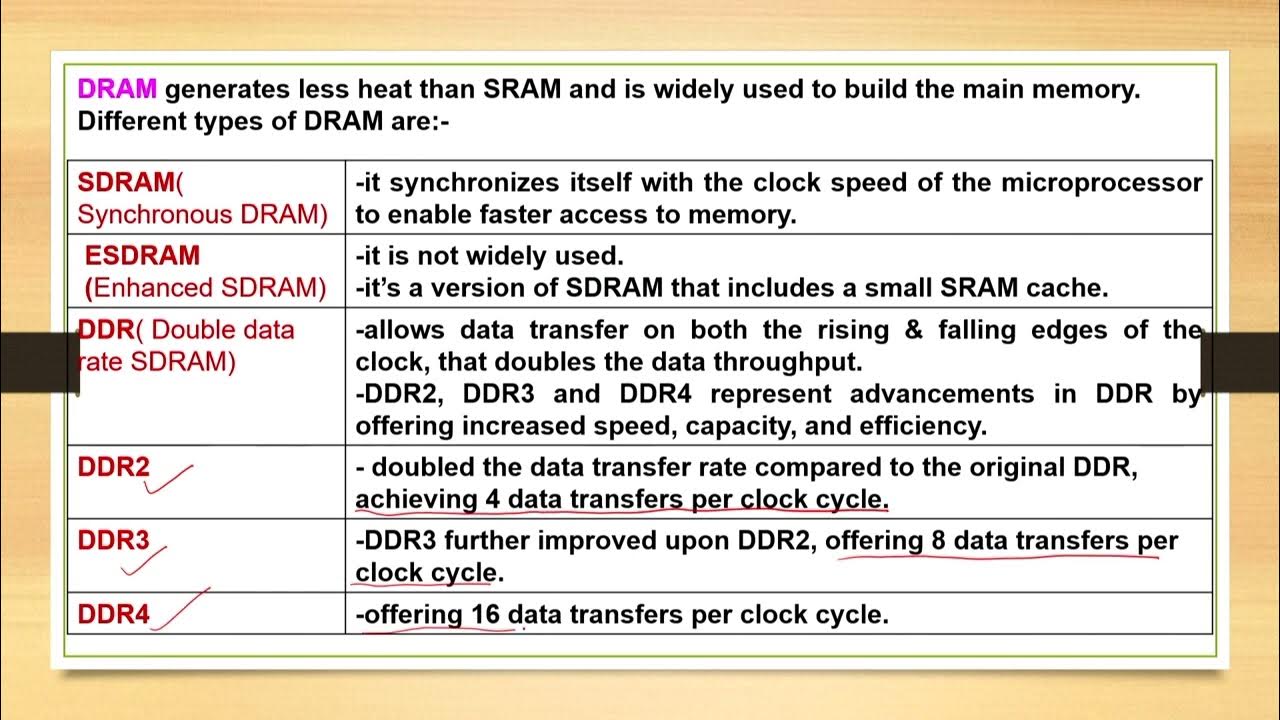Armazenamento e manipulação de dados em memória - Hierarquia de memória
Summary
TLDRThis lecture provides an overview of data storage and manipulation in computer memory. It explains the organization of different memory types, focusing on the hierarchy of memory, which includes registers, cache, RAM, and secondary storage. The principles of locality—temporal and spatial—are discussed, illustrating how data access patterns impact memory management. Additionally, the concept of virtual memory is introduced as a solution for managing limited primary memory. The interaction between computer components and the execution cycle is highlighted, emphasizing the collaborative function of these elements in efficient program execution.
Takeaways
- 😀 Memory in computers is categorized into primary (temporary) and secondary (permanent) storage.
- 😀 The memory hierarchy impacts access speed and storage capacity, with faster memories being more expensive and closer to the CPU.
- 😀 The hierarchy includes registers, cache memory, RAM, and secondary storage like hard drives.
- 😀 Accessing data follows a top-down approach in the memory hierarchy, starting from the fastest memory levels.
- 😀 The human memory system inspires computer memory, with recent data stored in short-term and older data in long-term memory.
- 😀 The principle of locality states that recently accessed data is likely to be used again (temporal locality).
- 😀 Spatial locality indicates that data near recently accessed data is also likely to be accessed soon.
- 😀 Virtual memory extends primary memory using secondary storage, managed automatically by the memory management unit.
- 😀 Algorithms determine which data to replace in memory, influenced by locality principles to optimize performance.
- 😀 The computer's components interact through a bus system, executing instructions via the fetch-decode-execute cycle.
Q & A
What are the two main categories of computer memory?
-The two main categories of computer memory are primary memory, which is used for temporary storage during program execution, and secondary memory, which stores information even when the computer is off.
What is the memory hierarchy, and why is it important?
-The memory hierarchy is the organization of different types of memory based on access speed and storage capacity. It is important because it determines how efficiently a computer can access and manage data.
How does the CPU access memory addresses?
-The CPU accesses memory addresses by checking from the top of the memory hierarchy downwards. It first looks in the registers, then in cache memory, RAM, and finally in secondary memory if necessary.
What is the principle of locality, and how does it affect memory usage?
-The principle of locality suggests that recently accessed data is more likely to be accessed again soon (temporal locality) and that data located close together in memory is likely to be accessed sequentially (spatial locality). This influences how data is stored and retrieved to improve performance.
What is virtual memory?
-Virtual memory is a technique that uses secondary memory as an extension of primary memory, allowing a computer to run more programs than it can physically store in RAM.
How does the memory management unit (MMU) function?
-The memory management unit automatically retrieves data from primary memory. If the data is not there, it fetches it from secondary memory, creating a copy in primary memory for use.
What are the challenges associated with the growing demand for memory in computers?
-As programs become larger and more numerous, there is a need for more primary memory, which is costly. This can lead to some programs being neglected or not accessed, wasting valuable memory resources.
What is the cycle of fetch-execute in a computer system?
-The fetch-execute cycle involves retrieving instructions and data from memory, determining the components needed to execute the instruction, and then performing the necessary actions with those components.
How does the system decide which content to remove from memory?
-The system removes less relevant content based on principles of locality, with various algorithms available to influence performance regarding which data should be replaced.
Why are higher levels of memory in the hierarchy more expensive?
-Higher levels of memory, such as cache and registers, are faster and therefore more expensive to produce, leading to a trade-off between speed and storage capacity.
Outlines

Этот раздел доступен только подписчикам платных тарифов. Пожалуйста, перейдите на платный тариф для доступа.
Перейти на платный тарифMindmap

Этот раздел доступен только подписчикам платных тарифов. Пожалуйста, перейдите на платный тариф для доступа.
Перейти на платный тарифKeywords

Этот раздел доступен только подписчикам платных тарифов. Пожалуйста, перейдите на платный тариф для доступа.
Перейти на платный тарифHighlights

Этот раздел доступен только подписчикам платных тарифов. Пожалуйста, перейдите на платный тариф для доступа.
Перейти на платный тарифTranscripts

Этот раздел доступен только подписчикам платных тарифов. Пожалуйста, перейдите на платный тариф для доступа.
Перейти на платный тарифПосмотреть больше похожих видео
5.0 / 5 (0 votes)






